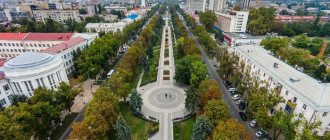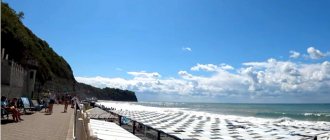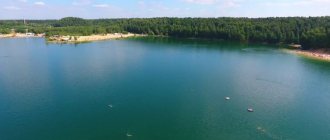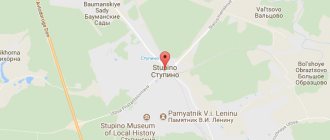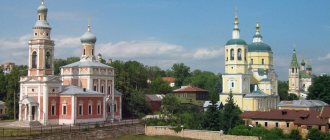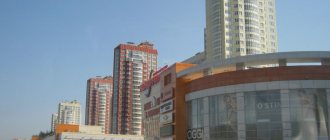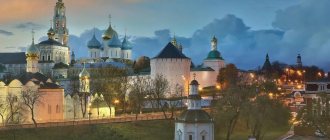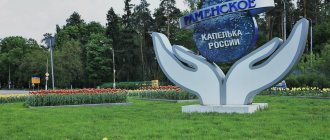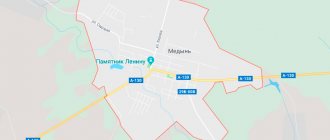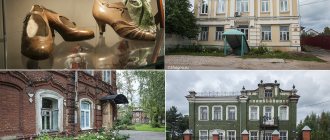General information and history of Krasnogorsk
The glorious city of Krasnogorsk is located not somewhere high in the mountains, as one might think based on its name, but in the Moscow region, just 23 kilometers northwest of the center of the Capital and 2 kilometers from the Moscow Ring Road.
Krasnogorsk!
The first mention of the villages, which acquired urban status several centuries later, occurs in the middle of the 15th century: the heirs of Prince Vasily the Dark learned about them from the will. It is not known what the princely descendants did, but after 200 years, other noble families settled on the site of the future Krasnogorsk, for example, the Volynsky and Dolgoruky. After another 2 centuries, the Polyakovs, who owned several weaving factories, made an invaluable contribution to the development of the future city.
In addition, the economic growth of Krasnogorsk was positively influenced by the Bolshaya Voskresenskaya Road, now the Volokolamsk Highway, and the Moscow-Vindavskaya Railway passing through it.
After the revolution, weaving and dyeing production in the village of Banki came to an end, and the future Krasnogorsk was rescued from a difficult economic situation by the transfer of a small optical plant from Podolsk to it. Finally, in 1931, the Soviet authorities decided to build a large optical plant here and christen the city itself Optikogorsk, but after that they still called it Krasnogorsk: apparently it was more communist. By the way, Krasnogorsk was officially given city status only in 1940.
Pionerskaya Street (1957)
During the war, a camp for prisoners of war was organized on the territory of the city. Two points are interesting here: firstly, Field Marshal Paulus managed to visit it, and secondly, it was with the hands of the invaders that the Bruschaty settlement microdistrict was partially built. By the way, they built everything very well, apparently they wanted to emphasize German quality.
After the war and up to the present day, Krasnogorsk is actively developing: new social facilities are appearing, residential complexes are being built, and nearby villages are being included in the city. This, of course, may be good for some, but it’s still scary: the Moscow region is not rubber either.
Municipal-territorial structure
Cartographic description of the boundaries of settlements in the Krasnogorsk district, approved by the law of the Moscow region.
From 2006 to 2022, the Krasnogorsk municipal district included 4 municipalities, including 2 urban settlements and 2 rural settlements:
| № | Municipality | Administrative center | Number of settlements | Population (persons) | Area (km²) |
| 1e-06 | Urban settlement: | ||||
| 1 | Krasnogorsk | Krasnogorsk city | 3 | ↗153 672[4] | 59,52[26] |
| 2 | Nakhabino | working village of Nakhabino | 4 | ↗43 025[4] | 60,42[26] |
| 2.000002 | Rural settlement: | ||||
| 3 | Ilyinskoe | village Ilyinskoye | 21 | ↗22 165[4] | 76,16[26] |
| 4 | Otradnenskoye | Otradnoe village | 9 | ↗12 811[4] | 28,89[26] |
On January 9, 2022, the settlements were abolished with the transformation of the municipal district into an urban district.
Climate and ecology of Krasnogorsk
The climate of Krasnogorsk is not far from Moscow, except that it lost a couple of degrees along the way: it is still the same moderate continental with cold winters and warm summers. According to statistics, the average temperature in January is -9C°, and in July - +19C°.
There is no shortage of precipitation in the city: even short-term summer rain will slightly perk up the streets, and heavy snowfall will emphasize the onset of winter.
At the same time, the weather itself is unstable, so it can make Krasnogorsk residents swelter from the heat or cover everything with snow so that they have to, for example, dig out their own car, left to sleep in the open air. The good news is that there are practically no strong winds in the city, because this saves it from the dirty air that can come from the capital.
Winter on Ivanovo Ponds
The environmental situation in Krasnogorsk is only getting worse. This is due to the fact that forests are being cut down around, the air is being polluted because of the roads running through the city, and local enterprises, although not engaged in the chemical industry, still dispose of their waste somewhere.
By the way, it must be emphasized that it is in terms of ecology that Krasnogorsk is one of the most polluted cities near Moscow. At the same time, on the Internet, mostly on real estate websites, you can find information that Krasnogorsk is an ideal place to live, because there is a vast green area, rivers, practically waste-free factories and the absence of wind from the Moscow direction. At the same time, they are silent not only about the fact that forests are cut down specifically for construction, but also about the fact that many trees are diseased, and the city’s groundwater has long contained various chemical compounds.
In general, if you decide to move to Krasnogorsk, then get ready for the fact that you will live in an ordinary Moscow region, and not in some ecopolis.
Population of Krasnogorsk
The population of Krasnogorsk, according to data at the beginning of 2019, is approximately 172 thousand people.
The population is gradually growing, and this happens in the most natural way: they travel. Those who do not have enough space in the capital come to the city, i.e. not even space, but money, because buying an apartment in Krasnogorsk is easier than in Moscow. It is quite difficult to even call this part of the population Krasnogorsk residents, because, having housing in this city, they work and spend most of their time in the capital.
Parade on May 9 in Krasnogorsk
As for the indigenous people, this also has its own specifics. Those who were born and raised in the old microdistricts of the city, for example, Teply Beton or SGSh, consider themselves to be native Krasnogorsk residents. But those who are natives of villages annexed to the city consider this village their small homeland. Let’s say someone who was born and lives in Opalikha will call himself an Opalikha resident, but someone who has already arrived in this microdistrict can call himself a Krasnogorsk resident.
Culturally, the residents of Krasnogorsk differ little from the residents of Moscow or any other city. There are the so-called elite, the intelligentsia, the middle class, and the workers. If you want to get acquainted with the first class, then you should look, for example, at the City Administration or to the director of one of the local enterprises; you can meet the intelligentsia at exhibitions or literary evenings, workers - of course, in factories.
By the way, if you really decide to make friends or acquaintances in Krasnogorsk, then it is important not to confuse people who are just peacefully drinking with local schoolboys and gopniks who, before drinking, will definitely take someone’s wallet or phone. In general, Krasnogorsk people are normal people, but exceptions are found everywhere. This is the Russian reality...
General characteristics of the city
Public transport in the city is represented by minibuses, buses, trains, and there is also a Myakinino metro station. Medicine is of high quality, but quite expensive. For example, calling a doctor to your home costs from 2,500 rubles.
There are not only pros, but also cons of living in Krasnogorsk. Thus, the local water contains a huge amount of fluoride, which turns the teeth of the local population black, although in this state they are not susceptible to caries.
Living here, you will have to be prepared for gigantic traffic jams, fairly high rents and mediocre quality of service. The city is seriously short of kindergartens, so modern residential complexes already include them, but places in them are still taken up quite quickly, even enrolling children from birth.
In 2000, the population of Krasnogorsk was 90.6 thousand people. At the moment it has increased to 175.5 thousand. And the reason for this is population migration.
Also, the active pace of housing construction has brought Krasnogorsk to the forefront. In terms of the volume of new housing commissioned in the Moscow region, only Khimki is ahead of it.
Districts and real estate of Krasnogorsk
Today, Krasnogorsk includes the following microdistricts: District Center, Teply Beton, SGS, Chernevo, Gubaylovo, Pavshino, Anino, Opalikha, Bruski, Yuzhny, Pavshinskaya Poima and Spassky Bridge. The city is also surrounded, but not included, by numerous cottage villages: Artek, Klenovo, Novoarkhangelskoye, Nikolskaya Sloboda and others.
Krasnogorsk map
Microdistrict District Center
It includes Komsomolskaya, Tsiolkovskogo, Dimitrova, Zheleznodorozhnaya, Krasnaya Gorka streets and others, and is the central part of the city, its business part. This is where the administration, the main post office, the city park, as well as a lot of shopping and entertainment facilities are located. Among the cultural heritage in this part of the city you can see and visit Ivanovo Ponds, the Znamenskoye-Gubailovo estate and the Znamenskaya Church.
As you can understand, the microdistrict has been formed for a long time, so its features include a developed infrastructure - a housing stock consisting mainly of Soviet-built panel houses. The cheapest 1-room apartment in the regional center will cost you 3.5 million rubles. At the same time, it will most likely have a modest appearance and require renovation, and your neighbors will be people over 40 who have devoted themselves to working at local enterprises.
St. Tsiolkovsky (district district center)
Microdistrict Warm concrete…
Thermal concrete, as locals used to call it, is considered the oldest in Krasnogorsk. Its construction took place in parallel with the construction of a mechanical plant. Here, on the site of old, outdated barracks, ordinary Soviet high-rise buildings were built, the apartments in which seemed like real mansions to the hard workers from the factory. Today, in architectural terms, Warm Concrete includes these very houses, modern high-rise buildings called the “Krasnogorsk Riviera”, and even one long-lived barracks in which the management of some organization is located.
With the infrastructure in the microdistrict, everything is more or less, but anything can happen: for example, accidents on the heating network, which result in a lack of hot water. Despite this, a one-room apartment here will cost about 4 million.
Warm concrete
Microdistrict SGS (dry gypsum plaster)
It's not going through the best times right now. The fact is that this part of the city is undergoing reconstruction: dilapidated houses are demolished, and new ones are being built or have already been built in their place. At the same time, problems arise not only due to constant noise, but due to the constant change of the construction plan and delays in its implementation.
The houses of the Soviet period, which can be said to have survived, are in a rather deplorable state: the entrances are terrible, the elevators are worn out, the staircases are dirty, and no one is going to repair them. This is how people live, although the infrastructure and transport links in the microdistrict are well developed. Prices for apartments here start at 3.5 million rubles.
Dry gypsum plaster
Microdistrict Chernevo
It is the most densely populated in Krasnogorsk, divided into two parts: Chernevo-1 and Chernevo-2. First Chernevo is distinguished by a well-developed infrastructure, a constant flow of traffic and Soviet-built high-rise buildings. Second Chernevo is recognized as the cleanest part of the city, because... This is where the ski slope is located and the green area is located.
The trouble is that in Chernevo-2, where modern high-rise buildings are already being built, the authorities and investors want to destroy Chernevskaya Gorka and Chernevskaya Polyana, and expand the construction processes in their place. Local residents are not enthusiastic about this idea and are trying with all their might to resist it: they write complaints, contact the authorities, organize a collection of signatures, etc. At the same time, a 1-room apartment in Chernevo costs from 3 million rubles.
Chernevo-1
Microdistrict Gubaylovo
Also divided into first and second. In addition, this microdistrict can be divided by type of development: multi-storey residential buildings and the private sector. At first glance, this part of the city seems quite prosperous: practically the city center, convenient transport links, many social facilities, but in reality the local residents have a lot of problems. Moreover, if apartment owners are faced with the usual poor performance of housing and communal services in our country, poor courtyards and a lack of parking spaces, but residents of the private sector suffer from constant delays in garbage collection, queues at clinics and developers who want to designate one-story houses for demolition, and on their place, of course, to begin construction. Despite this, an apartment in Gubaylovo will cost approximately 4.2 million.
Houses on Pushkinskaya Street (Gubailovo-2)
Microdistrict Bruski...
...or the Bruschaty settlement, the same one that was partially built by prisoners, is being rebuilt today. Houses that have outlived their usefulness are demolished, the population is resettled, construction begins... This whole process is quite slow, the people are dissatisfied. To date, several houses have been commissioned in the Real Park residential complex. A square meter of finished housing here starts at 100 thousand rubles.
Microdistrict Yuzhny
It is located not so far from the capital, continues the list of areas that continue to be built. In this part of the city, the largest architectural structure is rightfully considered the Ilyinsky Park residential complex, where a square meter costs from 90 thousand rubles. The houses here, of course, are not bad and are considered to be business-class real estate, but despite this constant construction, the lack of kindergartens, schools and clinics, as well as the poor surrounding area, interfere with a carefree life near Moscow.
In "Yuzhny"
Microdistrict Opalikha
It is a former holiday village, which has been part of Krasnogorsk for about 10 years. You can write a lot about her, but if you try to explain it briefly, Opalikha Opalikha is different. This is explained by the fact that this microdistrict includes an ordinary private sector, modern town houses, and a modern residential complex “Emerald Ponds”, a one-room apartment in which will cost more than 3 million rubles.
The neighborhood has problems. These include, for example, the dilapidated condition of some residential buildings or the lack of parking spaces near the railway station. These problems have existed for a certain number of years and are still being solved.
Opalikha
Microdistrict Anino
It is a neighbor of the aforementioned Opalikha and Chernevo. Actively engaged in construction. A square meter here is offered at a price of 85 thousand per piece, and there is practically no infrastructure.
New building in Anino
Microdistrict Pavshino
It is a new microdistrict, on the site of which there used to be an ordinary village, and today there is a modern residential complex. The basis of Pavshino is the “Art” residential complex, which includes modern high-rise buildings. By the way, it is in this residential complex that the tallest 30-story residential complex in Krasnogorsk is located.
Among the advantages of this microdistrict, it is necessary to highlight its convenient transport location (proximity to the railway platform, many minibuses and buses), as well as the progressive development of infrastructure: this includes the beginning of the construction of a kindergarten. The disadvantages include the lack of parking spaces, periodic problems with elevators and, according to some, the high cost of the apartments themselves, and a square meter in this residential complex costs an average of 100 thousand rubles.
Pavshino from above
Microdistrict Pavshinskaya floodplain
It belongs to the category of young parts of the city, but at the same time this area enjoys some fame due to its problems. Local residents, who were supposed to be given modern housing with all amenities, received further promises. Thus, in the Pavshinskaya floodplain there are not enough places in kindergartens and schools, and the construction of new ones is delayed, there is a noticeable shortage of parking, there are interruptions in the heat supply, and in order to get to the nearest metro station, which, by the way, is just a stone’s throw away, you need sail on a ferry or risk your life to walk on ice.
Local residents are already so tired of all this that they even began to organize rallies, and developers at this time are in no hurry to reduce prices for apartments: a square meter from 70 thousand rubles.
Pavshinskaya floodplain today
Microdistrict Spassky Most
It borders on the Pavshinskaya floodplain and also consists entirely of new buildings and unfinished new buildings. The disadvantages of this area are approximately the same as those of its neighbor, plus you need to add to them the delay in delivery of finished houses, incomprehensible amounts in the utility bill and all sorts of cleverly thought-out clauses in contracts. In general, nothing new, and a 1-room apartment here will cost from 3.5 million rubles.
Freshly built high-rise buildings on Krasnogorsky Boulevard (Spassky Most microdistrict)
As for cottage villages, they consist of luxurious town houses, mostly owned by wealthy Muscovites. The infrastructure is developed very well or will be developed very well, because... In such villages, construction proceeds quickly and efficiently. The finished house will cost at least 5.5 million rubles.
Settlements
| № | Locality | Type | Population | former municipality |
| 1 | Alexandrovka | village | ↘199[27] | rural settlement Ilyinskoye |
| 2 | Angelovo | village | ↗243[27] | rural settlement Otradnenskoye |
| 3 | Aristovo | village | ↘36[27] | rural settlement Otradnenskoye |
| 4 | Arkhangelskoe | village | ↗4443[27] | rural settlement Ilyinskoye |
| 5 | Buzlanovo | village | ↘162[27] | rural settlement Ilyinskoye |
| 6 | Funnels | village | ↗182[27] | rural settlement Ilyinskoye |
| 7 | Gavrilkovo | village | ↗344[27] | rural settlement Otradnenskoye |
| 8 | Glukhovo | village | ↗291[27] | rural settlement Ilyinskoye |
| 9 | Golyevo | village | ↗491[27] | urban settlement Krasnogorsk |
| 10 | Gribanovo | village | ↗92[27] | rural settlement Ilyinskoye |
| 11 | Dacha farm "Arkhangelskoye" | village | ↗1263[27] | rural settlement Ilyinskoye |
| 12 | Dmitrovskoe | village | ↗602[27] | rural settlement Ilyinskoye |
| 13 | Zhelyabino | village | ↗131[27] | urban settlement Nakhabino |
| 14 | Zakharkovo | village | ↗470[27] | rural settlement Ilyinskoye |
| 15 | Ivanovskoe | village | ↘129[27] | urban settlement Krasnogorsk |
| 16 | Ilyinskoe | village | ↘478[27] | rural settlement Ilyinskoye |
| 17 | Ilyinskoye-Usovo | village | ↘1504[27] | rural settlement Ilyinskoye |
| 18 | Engineering-1 | village | ↗1134[27] | rural settlement Ilyinskoye |
| 19 | Istra | village | ↘1173[27] | rural settlement Ilyinskoye |
| 20 | Kozino | village | ↗595[27] | urban settlement Nakhabino |
| 21 | Korostovo | village | ↗247[27] | rural settlement Otradnenskoye |
| 22 | Krasnogorsk | city | ↗175 812[28] | urban settlement Krasnogorsk |
| 23 | Maryino | village | ↗149[27] | rural settlement Otradnenskoye |
| 24 | Mechnikovo | village | ↗2427[27] | rural settlement Ilyinskoye |
| 25 | Mikhalkovo | village | ↗39[27] | rural settlement Ilyinskoye |
| 26 | Nakhabino | workers' village | ↗46 487[29] | urban settlement Nakhabino |
| 27 | Nefedyevo | village | ↗31[27] | urban settlement Nakhabino |
| 28 | Nikolo-Uryupino | village | ↗693[27] | rural settlement Ilyinskoye |
| 29 | New | village | ↗2237[27] | rural settlement Ilyinskoye |
| 30 | Otradnoe | village | ↘1233[27] | rural settlement Otradnenskoye |
| 31 | Petrovo-Dalnee | village | ↗2001[27] | rural settlement Ilyinskoye |
| 32 | Pozdnyakovo | village | ↗273[27] | rural settlement Ilyinskoye |
| 33 | Putilkovo | village | ↗2464[27] | rural settlement Otradnenskoye |
| 34 | Saburovo | village | ↗145[27] | rural settlement Otradnenskoye |
| 35 | Svetlye Gory | village | →422[27] | rural settlement Otradnenskoye |
| 36 | Stepanovskoe | village | ↗95[27] | rural settlement Ilyinskoye |
| 37 | Timoshkino | village | ↗102[27] | rural settlement Ilyinskoye |
Infrastructure of Krasogorsk
The infrastructure of Krasnogorsk is a topic that is constantly discussed, because if there is a reason (and, believe me, there are plenty of them), then you definitely need to take advantage of it in order to somehow improve your life.
First, utilities occupy a place in discussions among Krasnogorsk residents. True, no matter how much you talk about them and don’t file so many complaints to higher authorities, there is little use; utility workers are probably immune to them. The only strange thing is that local residents have not yet developed immunity to constant interruptions in heat transfer, muddy water with a strange aftertaste, periodic accidents at wastewater treatment plants, huge snowdrifts near the entrances in winter, scary elevators (especially in the dark), and unrepaired residential buildings. houses, the amount for which constantly appears in the fat, the lack of storm sewerage and much more.
People complain, but they tolerate it, and utility workers, instead of fulfilling their direct duties, always find some excuse, for example, “this yard is no longer included in the service of our organization” or “this type of service is provided for an additional fee.”
In general, the service is noticeably lame, but at the same time it costs at least 4.5 thousand rubles per month.
Garbage collection delayed...
There are also problems with the transport system. The most important of them is the metro. It is, of course, not far off, but the path to it is not the easiest. The fact is that the Myakinino station is located just opposite the Pavshinskaya floodplain microdistrict, but the separator between them is the Moscow River. There is no bridge, or rather, they plan to build it only in 10 years. In the meantime, this problem is solved in the summer by ferry, and in the winter by walking on the ice, as they say, at the risk of life. In addition, at one time there was information that they could build a rope bridge, but something didn’t work out there either.
As for ground transport, there are a lot of buses and minibuses in Krasnogorsk that can take you to the desired microdistrict of the city, to the neighboring village, and to the nearest metro station. Here you cannot complain about a lack, but you can complain about the constant traffic jams that form at the exit and entrance to the city. The situation was aggravated by the expansion of the Novorizhskoe highway, due to which the entire traffic flow moved to Volokolamka and finally stopped it.
In such a situation, the only remaining option is the so-called fallback option, which is rail transport. Having safely reached one of the stopping points (Pavshino station, Krasnogorskaya square or Opalikha square), you can get to Moscow-Rizhskaya without any problems. You only have to be patient for half an hour - this is an ordinary train, not your own car.
On Volokolamka (Volokolamsk highway)
If we talk about the provision of social institutions in Krasnogorsk, then in the old microdistricts there is no shortage of schools, kindergartens and clinics, but you can always see a queue, for example, to see a local doctor. In the new microdistricts, there are queues not only for appointments with doctors, but also for reserving places in nurseries. There are so many of them that expectant mothers joke that in order to enroll their baby in kindergarten, they need to register in advance - somewhere around the 4th month of pregnancy. And this is very sad, because this fact immediately indicates the slow pace of development of microdistricts with social facilities and bribery of the type “if you want to enroll your child in a kindergarten, help the manager financially.” No love for children - money decides everything.
Notes
- from the point of view of the administrative-territorial structure
- from the point of view of the municipal structure
- ↑ 12
Law of the Moscow Region dated February 28, 2005 No. 70/2005-OZ “On the status and boundaries of the Krasnogorsk municipal district and newly formed municipalities within it” - ↑ 123456
Population of the Russian Federation by municipalities as of January 1, 2022 (Russian) (July 31, 2017). Retrieved July 31, 2022. Archived July 31, 2022. - ↑ 12
Law “On the organization of local self-government in the territory of the Krasnogorsk municipal district” - ↑ 12
Law “On classifying the city of Krasnogorsk, Krasnogorsk district of the Moscow region, as a city of regional subordination of the Moscow region, abolishing the Krasnogorsk district of the Moscow region and amending the Law of the Moscow region “On the administrative-territorial structure of the Moscow region”” - ↑ 12
Law of the Moscow Region No. 11/2013-OZ dated January 31, 2013 “On the administrative-territorial structure of the Moscow Region” - Law of the Moscow Region No. 166/2017-OZ “On amendments to the Law of the Moscow Region “On the border of the Krasnogorsk urban district” and the Law of the Moscow Region “On the status and boundaries of the Odintsovo municipal district and newly formed municipalities within it””
- All-Union Population Census of 1939. The current population of the USSR by regions and cities (unspecified)
. Retrieved November 20, 2013. Archived November 16, 2013. - All-Union Population Census of 1959. The actual population of cities and other settlements, districts, regional centers and large rural settlements as of January 15, 1959 by republics, territories and regions of the RSFSR (unspecified)
. Retrieved October 10, 2013. Archived October 10, 2013. - All-Union population census of 1970. The actual population of cities, urban-type settlements, districts and regional centers of the USSR according to census data as of January 15, 1970 by republic, territory and region (unspecified)
. Retrieved October 14, 2013. Archived October 14, 2013. - All-Union Population Census of 1979. The current population of the RSFSR, autonomous republics, autonomous regions and districts, territories, regions, districts, urban settlements, village-district centers and rural settlements with a population of over 5,000 people (unspecified)
. - All-Union population census of 1989. Population of the USSR, RSFSR and its territorial units by gender (undefined)
. Archived from the original on August 23, 2011. - All-Russian population census 2002. Volume. 1, table 4. Population of Russia, federal districts, constituent entities of the Russian Federation, districts, urban settlements, rural settlements - regional centers and rural settlements with a population of 3 thousand or more (unspecified)
. Archived from the original on February 3, 2012. - Alphabetical list of settlements in municipal districts of the Moscow region as of January 1, 2006 (unspecified)
(RTF+ZIP). Development of local self-government in the Moscow region. Access date: February 4, 2013. Archived January 11, 2012. - The size of the permanent population of the Russian Federation by cities, urban settlements and regions as of January 1, 2009 (unspecified)
. Retrieved January 2, 2014. Archived January 2, 2014. - Population census 2010. Population of Russia, federal districts, constituent entities of the Russian Federation, city districts, municipal districts, urban and rural settlements (Russian). Federal State Statistics Service. Access date: January 22, 2013. Archived April 28, 2013.
- Moscow region. Estimated resident population as of January 1, 2009-2016
- Population of the Russian Federation by municipalities. Table 35. Estimated resident population as of January 1, 2012 (unspecified)
. Retrieved May 31, 2014. Archived May 31, 2014. - Population of the Russian Federation by municipalities as of January 1, 2013. - M.: Federal State Statistics Service Rosstat, 2013. - 528 p. (Table 33. Population of urban districts, municipal districts, urban and rural settlements, urban settlements, rural settlements) (undefined)
. Retrieved November 16, 2013. Archived November 16, 2013. - Table 33. Population of the Russian Federation by municipalities as of January 1, 2014 (unspecified)
. Access date: August 2, 2014. Archived August 2, 2014. - Population of the Russian Federation by municipalities as of January 1, 2015 (unspecified)
. Access date: August 6, 2015. Archived August 6, 2015. - Population of the Russian Federation by municipalities as of January 1, 2016 (Russian) (October 5, 2018). Retrieved May 15, 2022. Archived May 8, 2022.
- Pavshinskaya floodplain is a very good place (unspecified)
.
RMNT.RU.
_ - Krasnogorsk authorities will publish information about empty spaces in the public domain (unspecified)
(February 22, 2017). - ↑ 1234
(Moscow region. Total area of municipal land - ↑ 1 2 3 4 5 6 7 8 9 10 11 12 13 14 15 16 17 18 19 20 22 23 24 25 26 27 28 29 30 31 32 33 34 35
The number of rural population and its distribution in the Moscow region ( the All-Russian census and population 2010).
Volume III (undefined)
(DOC+RAR). M.: Territorial body of the Federal State Statistics Service for the Moscow Region (2013). Retrieved October 20, 2013. Archived October 20, 2013. - The permanent population of the Russian Federation by municipalities as of January 1, 2022 (Russian). Retrieved April 27, 2022. Archived May 2, 2022.
- Estimation of the permanent population of the Moscow region as of January 1, 2022 and on average for 2022 for municipalities (unspecified)
. Mosoblaststat. Access date: April 20, 2022. - Handbook on the administrative-territorial division of the Moscow region 1929-2004. - M.: Kuchkovo pole, 2011. - 896 p. — 1500 copies. — ISBN 978-5-9950-0105-8.
- Rating of sustainable development of Russian cities (unspecified)
.
agencysgm.com
. - ↑ 1 2 3
Results of the activities of the Administration of the Krasnogorsk Municipal District in 2011
(unspecified)
. // krasnogorsk-adm.ru. Date of access: March 6, 2012. (inaccessible link) - The magic of iron Rembrandt // Moskovsky Komsomolets No. 25163 dated September 22, 2009
Enterprises and work in Krasnogorsk
The economy of Krasnogorsk is represented by a number of enterprises that employ a certain part of the local population. In addition, the service sector and construction, of course, make a huge contribution to the development of the city.
The city-forming enterprise is the Krasnogorsk plant named after. S. A. Zvereva. It was here that Zenit cameras, famous throughout the Soviet Union, were produced, as well as components for them. Today the plant produces various sighting systems and control systems for the Ministry of Defense, creates systems used in the field of astronautics, produces laser surveillance systems, medical devices, parts for optical devices and much more. Get a job at the Krasnogorsk plant named after. S. A. Zverev is possible, because There are all vacancies here, however, they are all workers. For example, at the moment, the company requires a turner of the 4th or higher category with specialized education and work experience; they promise a salary of 35 thousand rubles. In addition, in the list of KMZ vacancies you can find a milling machine operator, machine operator, mechanic, fitter, etc.
By the way, specialized education means the Krasnogorsk Optical and Mechanical College, whose graduates work at the plant.
Krasnogorsk plant named after. S.A. Zverev
Also, if you, as a true proletarian, are interested in finding employment specifically at a plant, you can try to get a job at such enterprises as the Knauf building materials plant, or rather its branch, which produces asphalt, or. Although these enterprises produce different products, their list of vacancies is approximately the same: ordinary workers with Slavic appearance and work experience are required everywhere.
A more or less sweet life is guaranteed by employment at such Krasnogorsk enterprises as OJSC Khlebprom or the Konfael confectionery factory. True, this will be very difficult to do if you do not have some kind of connections. At the moment, only a sales representative can get a job in the bread sector, and then you need to have a higher education, work experience, Russian citizenship, good appearance and be an experienced PC user, and at the same time the stated salary is only 35 thousand rubles. With this situation, it’s easier to get a job as a milling machine operator at KMZ or, for example, start distributing cosmetics.
If none of the vacancies listed above appeals to you, then there are three options left: construction (they hire everyone and don’t set any requirements), large retail chains that are constantly looking for salespeople, merchandisers, security guards and people to carry out various promotions, as well as Moscow, where a considerable part of Krasnogorsk residents are employed.
The choice is yours
Crime
There is crime in Krasnogorsk. Well, where would we be without him? Every day about a dozen crimes happen in the city, which have even become the norm.
In the first place are thefts and they come in different forms. For example, ordinary hard workers are not averse to stealing some expensive device, such as a drill or electric saw, from their place of work. The type of theft for which a person of any social status can be convicted is the removal of unpaid goods from stores. It’s not even greed that plays the main role here, but the habit of “taking what’s bad.” Many people automatically put some small item in their pocket, such as a chocolate bar, and then, forgetting about it, end up at the police station.
Apartment burglaries also happen in Krasnogorsk, and there was a case when the door was simply kicked in, all valuables were taken and they left. Nobody saw anyone.
Second place should be given to petty hooliganism. In general, “go-stop”! They came around the corner, and then the victim doesn’t really remember anything: he was left without a wallet or a mobile phone.
In third place are car thefts, as well as fraud using credit cards and mobile communications.
As for other types of crimes, we can simply say: they happen, but the less often the better.
